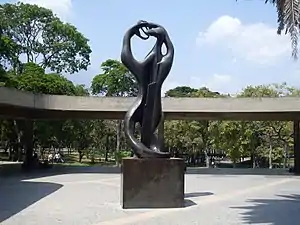L'Amphion
L'Amphion is a work of art by Henri Laurens, located in the Plaza Cubierta of the University City of Caracas. It is described as his "most famous sculpture".[1]
| L'Amphion | |
|---|---|
 | |
| Artist | Henri Laurens |
| Year | 1953 |
| Location | Caracas |
| Owner | Central University of Venezuela |
Background
The Venezuelan architect and designer Carlos Raúl Villanueva began designing the University City of Caracas campus in the 1940s, beginning construction in the 1950s[2] during a time of prevailing Modernism in Latin America.[3]
Villanueva hired many artists from around the world to contribute works to the campus, including Laurens.[note 1] Laurens had not had formal art training, and began his career as a stonemason, exploring Cubism from around 1912.[1]
Design and construction
Villanueva reportedly asked, in 1952, for Laurens to build him something "tremendous" for his campus project; later that year, he began creating L'Amphion. The sculpture is over 4 metres tall and rendered in bronze, sitting on top of a stone block.[1]
Laurens died in 1954, shortly after completing L'Amphion.[1] A copy of the sculpture exists at the Dallas Museum of Art.[4]
Appearance
L'Amphion is seen as a product of Laurens' development of style, an evolution between Cubist and Curvilinear art forms. It is also indicative of the female form that many of Laurens' more curving sculptures represent. Though made of bronze, the sculpture is a "grayish-black" shade. The consistency of the material is solid, except for an area on the front where there are decorative stripes on the 'belly'.[1] The shape is based on the Greek mythological Amphion.[4] Annette Labedzki refers to the sculpture as a feminine form, but with smooth curves that give "a mermaid like appearance", and describes it as having "its two hands raised and joined to form a circular shape, resembling a dancing gesture".[1]
See also
| Wikimedia Commons has media related to L'Amphion by Henri Laurens. |
Notes
References
- "His Most Famous Sculpture (L'Amphion) – Henri Laurens". canteramelia. 2012-02-09. Retrieved 2019-09-30.
- Pintó, Maciá (2008). Jiménez, Ariel (ed.). The Constructive Achievement of Synthesis. Alfredo Boulton and His Contemporaries: Critical Dialogues in Venezuelan Art, 1912–1974. Translated by Kristina Cordero and Catalina Ocampo. Museum of Modern Art. pp. 355–360. ISBN 9780870707100. Archived from the original on 2018-08-28. Retrieved 2018-08-27.
- Segawa, Hugo (2008). RIO DE JANEIRO, MÉXICO, CARACAS: CIDADES UNIVERSITÁRIAS E MODERNIDADES 1936 - 1962 (in Portuguese). Revista de Urbanismo e Arquitetura. p. 44.
- "Amphion - DMA Collection Online". www.dma.org. Retrieved 2019-09-30.
.jpg.webp)